Picture this: a lush, evergreen Maki Podocarpus plant gracing your home or garden, its vibrant foliage transforming your space into a serene oasis. 🌟 Whether you’re a plant enthusiast or a beginner, the Maki Podocarpus plant is your ticket to low-maintenance greenery that thrives year-round. This compact cultivar of Podocarpus macrophyllus is adored for its dense, needle-like leaves and versatility, making it perfect for indoor pots, outdoor hedges, or even bonsai creations. In this comprehensive guide, we’ll unlock the secrets to growing a thriving Maki Podocarpus plant, covering everything from light and soil to pruning and troubleshooting. Backed by horticultural expertise and practical insights, this article will empower you to cultivate a healthy, stunning plant that elevates your space. Let’s dive in! 🌲
1. What Is a Maki Podocarpus Plant? 🌲
1.1 Overview of the Maki Podocarpus 🌿
The Maki Podocarpus, scientifically known as Podocarpus macrophyllus ‘Maki,’ is a compact, slow-growing evergreen shrub native to East Asia. Often referred to as the Japanese yew or Buddhist pine, this cultivar is prized for its dense, dark green foliage and manageable size, typically reaching 6–8 feet tall and 2–3 feet wide outdoors, or smaller when potted indoors. Unlike its larger relatives, the Maki’s petite stature makes it ideal for small gardens, patios, or indoor spaces. Its soft, needle-like leaves give it a refined, elegant look, perfect for both modern and traditional aesthetics.
1.2 Benefits of Growing Maki Podocarpus 🌟
Why choose a Maki Podocarpus plant? For starters, its year-round greenery adds timeless beauty to any setting. Indoors, it doubles as an air-purifying plant, improving air quality by filtering pollutants, as noted by studies from institutions like NASA. Outdoors, it’s a versatile landscaping star, serving as a hedge, border, or standalone shrub. Its low-maintenance nature means less fuss for busy gardeners, and its adaptability to various climates (USDA Zones 7–11) makes it a favorite across regions. Plus, its non-toxic nature makes it safe for homes with pets or children, according to the ASPCA.
2. Understanding the Needs of Your Maki Podocarpus Plant 🌱
To grow a thriving Maki Podocarpus, you need to meet its core requirements: light, soil, water, and temperature. Let’s break it down.
2.1 Light Requirements ☀️
Maki Podocarpus plants thrive in bright, indirect light when grown indoors, mimicking their natural understory habitat. Outdoors, they prefer partial shade to full sun, depending on your climate. In hotter regions, provide afternoon shade to prevent leaf scorch, while cooler climates can handle more direct sunlight. A common mistake is placing the plant in deep shade, which can lead to sparse growth. Tip: Rotate indoor plants every few weeks to ensure even light exposure, promoting balanced foliage.
2.2 Soil Preferences 🌍
Well-draining, slightly acidic soil (pH 5.5–6.5) is key for a healthy Maki Podocarpus plant. For potted plants, use a mix of high-quality potting soil with perlite or sand to enhance drainage. Outdoors, amend heavy clay soils with organic matter like compost to improve aeration. Test your soil’s pH with a home kit, available at garden centers, and adjust with sulfur or lime if needed. Expert Tip: Avoid compacted soil, as it can suffocate roots and cause rot.

2.3 Watering Needs 💧
Consistency is crucial when watering your Maki Podocarpus. Keep the soil evenly moist but never soggy—think of it like a wrung-out sponge. During the growing season (spring and summer), water when the top inch of soil feels dry. In fall and winter, reduce watering as growth slows. Overwatering is a common pitfall, leading to yellowing leaves or root rot, while underwatering can cause drooping or browning. Use a moisture meter for precision, especially for indoor plants.

2.4 Temperature and Humidity 🌡️
Maki Podocarpus plants prefer temperatures between 60–75°F (15–24°C), making them ideal for most indoor environments. Outdoors, they tolerate mild winters but need protection from frost in colder zones (below 20°F or -6°C). Moderate to high humidity keeps their foliage lush, so indoor growers may need a humidifier or pebble tray in dry climates. Mist the leaves occasionally to boost humidity, but avoid over-misting to prevent fungal issues.
3. Step-by-Step Care Guide for Maki Podocarpus 🌿
Now that you understand its needs, let’s explore how to care for your Maki Podocarpus plant like a pro.
3.1 Planting Your Maki Podocarpus 🌱
Whether planting in a pot or garden bed, choose a location with good drainage and appropriate light. For potted plants, select a container with drainage holes, 1–2 inches larger than the root ball. Outdoors, dig a hole twice as wide as the root ball and mix in compost for nutrient-rich soil. Plant in spring or early fall to give roots time to establish before extreme weather. Water thoroughly after planting and mulch lightly to retain moisture.
3.2 Fertilizing for Healthy Growth 🌾
Feed your Maki Podocarpus with a balanced, slow-release fertilizer (e.g., 10-10-10) once a month during spring and summer. Avoid fertilizing in fall and winter, as the plant enters dormancy. Organic options like fish emulsion or compost tea work well for eco-conscious gardeners. Over-fertilizing can burn roots, so follow package instructions carefully. Expert Insight: If leaves yellow despite proper care, test for nutrient deficiencies and adjust your fertilizer accordingly.
3.3 Pruning and Shaping ✂️
Pruning keeps your Maki Podocarpus looking tidy and encourages dense growth. Trim lightly in early spring to shape hedges, topiaries, or bonsai forms. Use clean, sharp pruning shears to avoid tearing the foliage, and sterilize tools with rubbing alcohol to prevent disease spread. Remove dead or damaged branches anytime. For a polished look, trim the tips to promote bushiness. Avoid heavy pruning in late fall, as it can stress the plant before winter.
3.4 Repotting Tips 🪴
Repot your Maki Podocarpus every 2–3 years or when roots become crowded, typically indicated by slowed growth or roots circling the pot. Choose a pot slightly larger than the current one, refresh the soil, and gently loosen the root ball to encourage growth. Water thoroughly after repotting and keep the plant in indirect light for a week to reduce stress. Avoid repotting during winter, as the plant is less resilient during dormancy.

4. Common Problems and Solutions 🐛
Even with the best care, issues can arise. Here’s how to tackle them.
4.1 Pests and Diseases 🦟
Maki Podocarpus plants are relatively pest-resistant but may attract scale, aphids, or spider mites. Check leaves regularly for sticky residue or webbing. Treat infestations with neem oil or insecticidal soap, applied early in the morning to avoid leaf burn. Root rot, caused by overwatering, is the most common disease. Ensure proper drainage and avoid waterlogged soil. Expert Tip: Introduce beneficial insects like ladybugs for natural pest control in outdoor settings.
4.2 Troubleshooting Growth Issues 🌿
- Yellowing Leaves: Often caused by overwatering, poor drainage, or nutrient deficiencies. Check soil moisture and fertilize if needed.
- Stunted Growth: Likely due to insufficient light or compacted soil. Move to a brighter spot or aerate the soil.
- Drooping Foliage: Indicates underwatering or low humidity. Adjust watering and mist leaves to boost moisture.
5. Advanced Care Tips for a Show-Stopping Maki Podocarpus 🌟
Once you’ve mastered the basics, elevate your Maki Podocarpus plant care with these advanced techniques to make it a true centerpiece in your home or garden.
5.1 Propagating Maki Podocarpus 🌱
Propagating your Maki Podocarpus allows you to create new plants for free, perfect for expanding your collection or sharing with friends. The most effective method is stem cuttings:
- Step-by-Step Propagation:
- In spring, select a healthy, semi-hardwood stem (4–6 inches long) with several leaves.
- Cut just below a node using sterilized shears.
- Remove lower leaves, leaving 2–3 at the top.
- Dip the cut end in rooting hormone to boost success.
- Plant in a mix of perlite and peat moss, keeping it moist.
- Place in bright, indirect light and cover with a plastic bag to maintain humidity.
- Roots should form in 6–8 weeks; transplant once established.
- Seed Propagation: Less common due to slow germination, but possible with fresh seeds soaked for 24 hours before planting in a seed-starting mix.
Expert Tip: Patience is key—cuttings root faster in warm, humid conditions, so consider using a heat mat for faster results.
5.2 Creating a Bonsai Maki Podocarpus 🎍
The Maki Podocarpus plant is a bonsai enthusiast’s dream due to its compact growth and pliable branches. Here’s how to create a stunning bonsai:
- Shaping: Use wiring to gently guide branches into desired shapes, such as formal upright or cascade styles. Wrap wires loosely to avoid damaging the bark.
- Pruning: Regularly pinch back new growth to maintain miniature proportions. Focus on creating a balanced canopy.
- Care Adjustments: Bonsai plants need more frequent watering and careful light management due to their small pots. Use a bonsai-specific soil mix for optimal drainage.
Expert Insight: According to bonsai master John Naka, the Maki Podocarpus’s fine foliage makes it ideal for creating intricate, naturalistic designs that mimic ancient trees.

5.3 Seasonal Care Adjustments 🍂
Adapting care to seasonal changes ensures your Maki Podocarpus thrives year-round:
- Winter: Protect outdoor plants from frost with burlap wraps or by moving potted plants indoors. Reduce watering to prevent root rot in cooler temperatures.
- Summer: Monitor for heat stress in hot climates by providing afternoon shade and increasing watering frequency. Mist leaves to combat dry air.
- Spring/Fall: Ideal times for fertilizing, pruning, or repotting, as the plant is actively growing or preparing for dormancy.
Pro Tip: Transition indoor plants to outdoor settings gradually to avoid shock, starting with a few hours of outdoor time daily.
6. Maki Podocarpus in Different Settings 🏡
The versatility of the Maki Podocarpus plant makes it a star in both indoor and outdoor environments. Here’s how to maximize its potential in each.
6.1 Indoor Care Tips 🪴
Indoors, the Maki Podocarpus shines as a low-maintenance houseplant. Place it near a south- or east-facing window with filtered light to mimic its natural habitat. If natural light is limited, supplement with a grow light (6500K spectrum) for 10–12 hours daily. Maintain humidity with a pebble tray or humidifier, especially in winter when indoor air is dry. Dust leaves monthly to keep them vibrant and free of pests.
Styling Idea: Pair your Maki Podocarpus with a sleek ceramic pot for a modern look, or place it on a decorative stand to elevate small spaces like apartments or offices.
6.2 Outdoor Landscaping Ideas 🌳
Outdoors, the Maki Podocarpus is a landscaping powerhouse. Use it as a low hedge to define garden borders, a standalone shrub for focal points, or a topiary for artistic flair. Its dense foliage pairs beautifully with flowering plants like lavender or azaleas, creating a balanced garden design. For small yards, plant in containers to flank entryways or patios.
Expert Insight: Landscape designer Sarah Raven suggests combining Maki Podocarpus with ornamental grasses for a low-maintenance, evergreen-heavy garden that thrives in varied climates.

7. FAQs About Maki Podocarpus Care ❓
Here are answers to common questions to help you care for your Maki Podocarpus plant with confidence:
- Is the Maki Podocarpus toxic to pets? No, it’s non-toxic to cats and dogs, per the ASPCA, making it a safe choice for pet-friendly homes.
- How fast does it grow? Expect slow to moderate growth—about 6–12 inches per year under ideal conditions.
- Can it survive in low light? It tolerates low light but thrives in bright, indirect light. Prolonged low light may cause sparse foliage.
- Why are my plant’s leaves turning brown? Browning is often due to underwatering, low humidity, or direct sun exposure. Adjust care and monitor conditions.
- How often should I fertilize? Monthly during spring and summer with a balanced fertilizer; skip fertilizing in fall and winter.
8. Expert Insights and Pro Tips 🌟
Horticulturists praise the Maki Podocarpus for its resilience and versatility. Dr. David L. Morgan, a botanist with the Missouri Botanical Garden, notes, “The Maki Podocarpus’s compact form and evergreen nature make it a standout for both novice and experienced gardeners.” Here are additional pro tips:
- Lesser-Known Fact: The Maki cultivar produces small, berry-like cones in ideal conditions, adding ornamental interest outdoors.
- Sustainability Tip: Use rainwater or recycled graywater for watering to conserve resources, and compost kitchen scraps to enrich soil naturally.
- Pruning Hack: For a fuller plant, pinch back new growth regularly rather than relying on heavy pruning sessions.
Conclusion 🌿
Growing a thriving Maki Podocarpus plant is within your reach, whether you’re cultivating it as a houseplant, garden shrub, or bonsai masterpiece. By providing bright, indirect light, well-draining soil, consistent watering, and occasional pruning, you’ll enjoy lush, healthy foliage year-round. This guide has equipped you with expert-backed strategies to tackle common challenges, propagate new plants, and create stunning displays. Start your Maki Podocarpus journey today, and share your success stories in the comments or on social media! 🌱 Explore our related articles on evergreen care or bonsai techniques for more plant inspiration.













